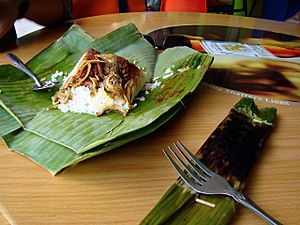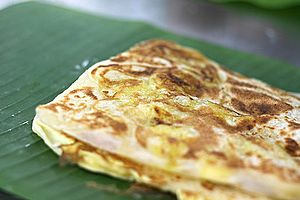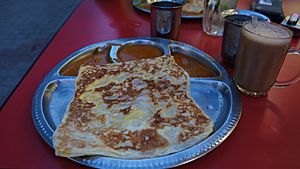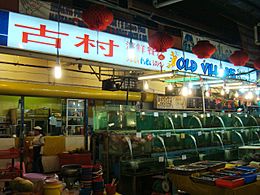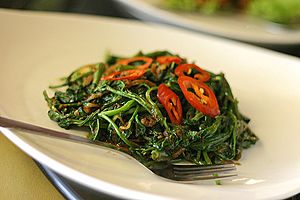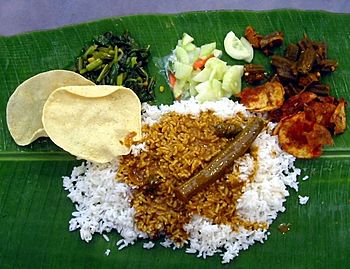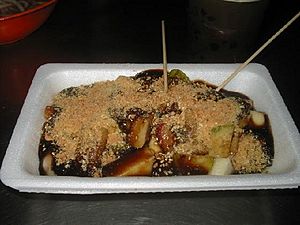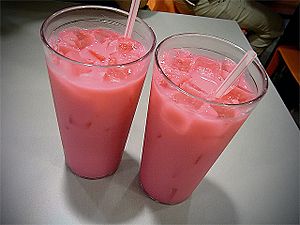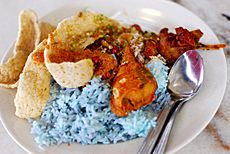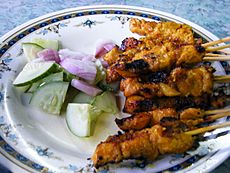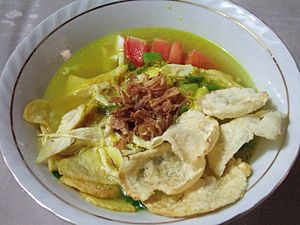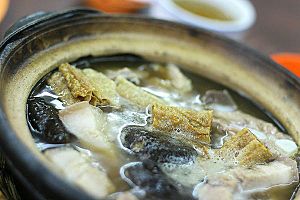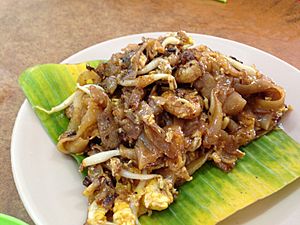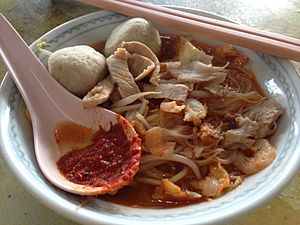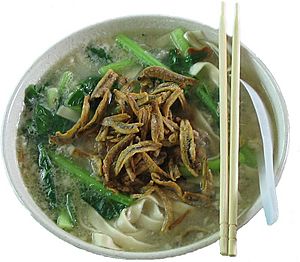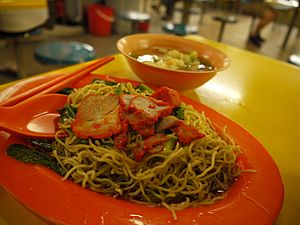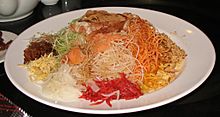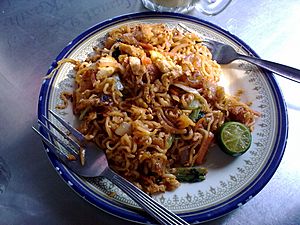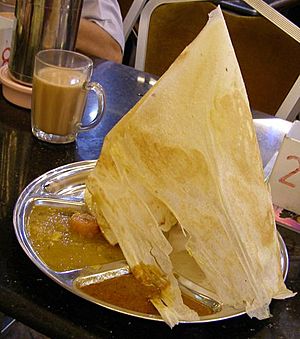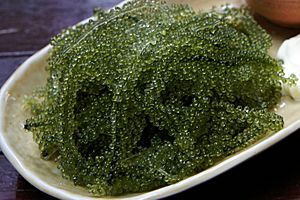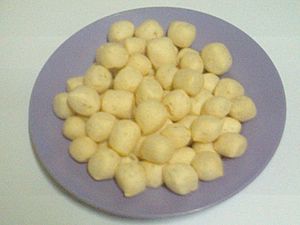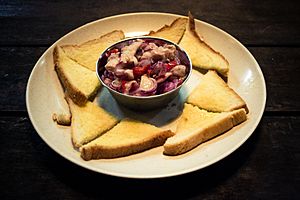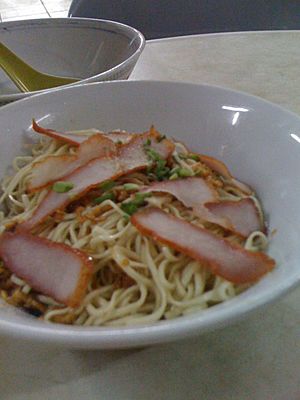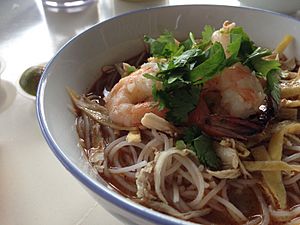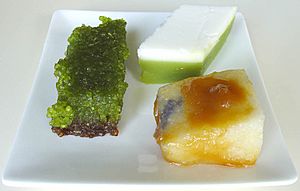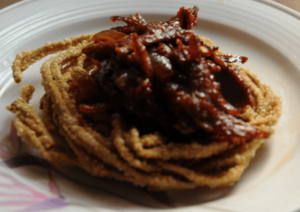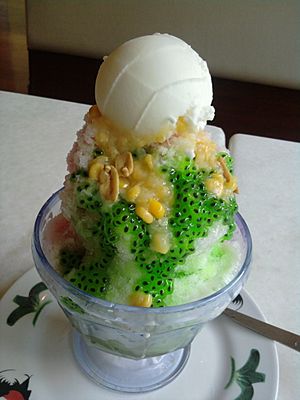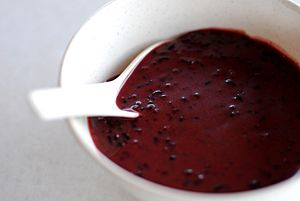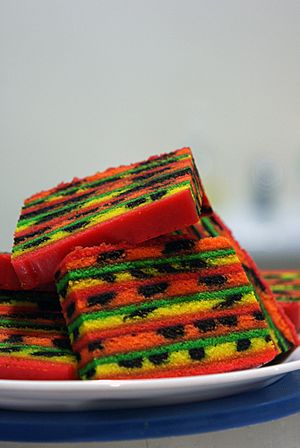Malaysian cuisine facts for kids
Malaysian cuisine is all about the amazing food traditions and cooking styles you find in Malaysia. It shows off the many different groups of people who live there, like the Malays, Chinese, and Indians. There are also native groups like the Dayak and Orang Asli, plus Peranakan and Eurasian communities.
Because of its history with people moving around, being colonized by other countries, and its location, Malaysian food today is a mix of many cultures. You'll find flavors from Malay, Chinese, Indian, Indonesian, and Filipino foods. There are also touches from Arab, Thai, Portuguese, Dutch, and British cuisines. This mix creates a huge variety of tastes, making Malaysian food very rich and diverse. The spices and herbs used in cooking are different for each dish.
Since Peninsular Malaysia shares history with Singapore, you'll often find the same dishes in both places, like laksa and chicken rice. The same goes for Malaysian Borneo and Brunei, where you'll find dishes like Ambuyat. Also, because they are close and have similar cultures, Malaysia shares food ties with Indonesia, Thailand, and the Philippines. They often have similar dishes like satay and rendang.
Most Chinese Malaysians came from southern China, so their food mostly comes from Fujian, Teochew, Cantonese, Hakka, and Hainanese cooking styles. Even though most Indian Malaysians came from southern India, their food is a mix of North and South Indian, and Sri Lankan styles. You can tell them apart by whether their curry dishes are drier or wetter.
Contents
History of Malaysian Food
How Malaysian Food Began
Malaysian food has grown and changed over a long time. Even though modern Malaysia started in 1963, its food history goes back to the 1400s, during the time of the Malacca Sultanate. Malaysian food is a blend of many food cultures from the Malay islands, India, China, the Middle East, and some European countries. This rich food culture comes from Malaysia's diverse people and its past as a colony.
In the 15th century, the area now called Malaysia became an important path for sea trade. Arab traders passed through, bringing spices from the Middle East. Portuguese, Dutch, and English colonists and traders also came, bringing new foods like peanuts, pineapples, avocados, tomatoes, squash, and pumpkins. In the 19th century, when the British ruled, many Indian and Chinese workers came to Malaysia, adding even more different tastes to Malaysian food.
Food Across Cultures and Regions
Because Malaysia is a country with many cultures, Malaysians have learned and changed each other's dishes over the years to fit their own tastes. For example, Chinese Malaysians have changed Indian curry to be less spicy and thinner, to suit their liking. Chinese noodles have been mixed with Indian and Malay flavors, leading to dishes like Malay fried noodles and Indian fried noodles. Malaysians have also taken famous dishes from nearby countries and made them their own, like tom yam from Thailand.
When Thai tom yam came to Malaysia, it became thicker and more orange-red, like a Malaysian Assam gravy. It tastes sweet, sour, and spicy. People often use tamarind instead of lime juice for sourness, and dried chillies for a fiery kick. Malay-style tom yam soup often has lots of seafood, while Chinese-style places make the broth less spicy and use it for noodle soup.
Across the sea from Peninsular Malaysia, on Borneo island, are the states of Sabah and Sarawak. Outside the big cities, traditional ways of life and limited roads are still common, especially in Sarawak. Rivers are the main "highways" for many people living inland. Borneo's jungles are full of wild plants, mushrooms, and fruits. Its long coastlines and many big rivers provide lots of seafood and freshwater fish.
Over centuries, the many tribes and native groups of Borneo have created a wide variety of traditional foods. Much of this food is healthy, made from things they found in the wild (now more often grown) and fermented foods. Because the Brunei Sultanate once ruled much of this area, the Bruneian Malay people had a lasting impact on the cooking of the coastal Muslim communities in East Malaysia.
Historically, fresh food was often hard to find for nomadic tribes, so they preserved it for important events and festivals. The tribal peoples of Sabah and Sarawak did the same. Most of them found ways to cure, ferment, or preserve their meat, fruit, and vegetable supplies. For example, during festivals, the Murut people of Sabah serve tamba (or jeruk in Malay). This is made from raw wild boar or river fish, stuffed into bamboo tubes with rice and salt, and left to ferment for a few weeks. The Lun Bawang people in Sarawak use a similar method. Fermented foods are also often used in cooking, not just eaten on their own. Dayak homes in Sarawak might stir-fry their fermented meat with garlic and tapioca leaves. Fermented tempoyak (durian paste) is a popular seasoning.
Making and drinking traditional alcohol is important for non-Muslim people in East Malaysia. Rice wine is the most common. In Sabah, the Penampang Kadazan lihing is very well known. But because there wasn't one standard Kadazandusun language, different groups in Sabah have many names for similar rice-based drinks, like hiing, kinomol, and tapai. It can be confusing because tapai in Peninsular Malaysia usually means a sweet and sour fermented rice paste eaten as a snack. The Murut people's favorite party drink, made from cassava, is also called tapai. The Iban people of Sarawak call their rice wine tuak, which is different from Sabahan talak, a strong liquor made from rice. For native Sarawakians, tuak can mean any alcoholic drink made from fermenting any food rich in carbohydrates, not just rice.
Food for the Nation
Countries often promote their national foods to attract tourists. But when a country has many ethnic groups, there can be disagreements about which dishes belong to the "national cuisine." Dishes that tourists find most appealing are heavily promoted as "typical" or "local." Malaysian food has been shown in media and ads as including dishes from many Asian ethnic groups and cultures. Malaysia is presented as a single place to try many different Asian foods. When the Ministry of Culture started a program to promote cultural tourism, they decided Malaysia would be promoted as a "meeting point of many different dishes from various ethnic groups" living in the country.
Another goal of national cuisine is to help different ethnic groups live together peacefully. After the race riots in 1969, Malaysia saw culture as a way to build a strong national identity. In 1979, Islam was officially recognized as an "important element in the national culture."
Main Foods
Rice
Rice (nasi in Malay) is the most important main food in Malaysia. There's evidence that rice was grown in Sarawak, Malaysian Borneo, as far back as 2300 BC, and in Kelantan, West Malaysia, for about 900 years. Today, Malaysia grows about 70% of the rice it needs and imports the rest. The government believes it's more profitable to use national resources for other industries and import rice. Still, the government is very involved in planning and supporting the rice farming industry. The state of Kedah is known as the "rice bowl" (jelapang padi) of the country, producing about half of Malaysia's total rice.
Plain steamed white rice, served with meat or vegetable side dishes, is usually made with an electric rice cooker at home. Some homes and restaurants cook rice on a stove. Compressed rice, called nasi himpit, is another way to prepare rice. The rice is wrapped in leaves, pressed into a cylinder shape, and then boiled. The rice sticks together during cooking. Compressed rice is usually eaten cold with gravy, but can also be served warm in soup. A special type of compressed rice made by the Bugis community is burasak: rice is pre-cooked with coconut milk, then wrapped in banana leaves and steamed until fully cooked.
Besides white rice, there are other types of local and imported rice. Each type needs a specific cooking method. Glutinous rice (pulut) is one example. Because it becomes sticky after cooking, it's prepared differently and can't be swapped with regular rice. It's usually used for snacks and desserts, but native peoples like the Orang Asli and Dayak people of Borneo also eat it as a savory main food. Lemang is glutinous rice roasted in a hollow bamboo tube. It's made for special events like Ari Gawai, Hari Raya Aidilfitri, and Hari Raya Aidiladha.
A popular rice dish in Malaysia is nasi lemak, which is rice steamed with coconut milk and pandan leaves for a lovely smell. It's from the Malay culture and is very popular, often called the national dish. It's usually served with ikan bilis (fried anchovies), peanuts, sliced cucumber, hard-boiled eggs, and sambal (spicy sauce). Even though it's often a breakfast dish, it's eaten at any time of day because it's so versatile. For a bigger meal, nasi lemak can come with fried chicken, curries, or a spicy meat stew called rendang.
Congee is a type of rice porridge popular among Malaysia's ethnic groups. It's mainly eaten for breakfast or a late supper. It's also good for sick people because it's mild and easy to digest. Congee is called bubur in Malay, zhou or juk in Chinese, and kanji in Tamil. It can be served plain or cooked with ingredients like fish, seafood, chicken, beef, pork, vegetables, and spices. Congee is so important that chicken congee (bubur ayam) is always on the menu at Malaysian McDonald's restaurants.
Noodles
Noodles are another popular main food, especially in Malaysian Chinese cooking, but other groups use them too. Noodles like bihun (rice vermicelli), kuay teow (flat rice noodles), mee (yellow noodles), mee suah (wheat vermicelli), and others offer another way to get carbohydrates instead of rice. Stir-fried noodle dishes (mee goreng) are found everywhere in Malaysia's cities, towns, and villages. Many local versions are made by different ethnic groups based on their cooking traditions.
Bread
Malaysia doesn't grow wheat, so all its wheat comes from other countries. Still, Western-style white bread and Indian breads made with wheat flour, like roti canai, are common foods.
Traditional steamed buns called bao (Chinese: 包子) are a Chinese staple that has become a big part of Malaysian food. You can find bao in restaurants that serve brunch dim sum, and in Chinese coffee shops (Kopi tiam). Sweet fillings can include red bean paste, lotus seed paste, kaya (coconut jam), pandan, ground peanuts, and custard. Savory fillings might be stewed char siu (Chinese BBQ pork), chicken, or pork. Malay versions (pau) are found in night markets (pasar malam) and are always halal, with fillings like curried potato, chicken, or beef. Some even have a quail egg in the middle with the curry.
Oven-baked buns are also available in bakeries, coffee shops, and restaurants. One special local bun, with a buttery center and a crispy, coffee-flavored crust, has become famous in Malaysia. Chains like Rotiboy and Pappa Roti, which specialize in these coffee buns, have even opened many stores in other countries. But the most popular buns among Malaysians are those filled with sweet shredded coconut, kaya (coconut jam), pandan kaya (screwpine with coconut jam), sweet corn, chocolate, red bean paste, and butter.
Other Main Foods
Like Peninsular Malaysia, rice is the main food for most people in Sabah and Sarawak. Rice is central to Kadazandusun culture, and its importance is seen in the yearly Kaamatan festival and old beliefs about rice spirits. But for other ethnic groups in Sabah and Sarawak, cassava (tapioca) and sago starch are also popular main foods. Cassava is as important as rice to the Bajau people of Sabah. The Dayak people of Sarawak use both the root and leaves of the cassava plant in their cooking. Sago starch comes from the sago palm and is the main food for the Melanau and Penan peoples of Sarawak.
Sago starch is made into a gooey, sticky paste called ambuyat by the Bisaya and Kedayan communities. The Melanau call it linut. People eat it by rolling the paste around a bamboo fork and dipping it into soup, sambal, or other sauces. Besides being a source of sago starch, the sago palm also provides another special food for the native peoples of Borneo: the sago grub. Called butod in Sabah and ulat mulong in Sarawak, sago grubs are usually eaten raw but can also be deep-fried, roasted, or stir-fried.
Protein Foods
Meat
Malaysian poultry (chicken) is prepared according to `halal` rules, which follow Islam, the country's main religion. Imported poultry can be found in big supermarkets, especially in richer areas with many foreign residents.
Fish, both from rivers and the sea, is a big part of the Malaysian diet. Most local fish is bought soon after it's caught, while frozen fish is usually imported. Fish like salmon and cod are popular in Malaysia but don't live in Malaysian waters. Many types of seafood are eaten in Malaysia, including shrimp or prawn, crab, squid, cuttlefish, clams, cockles, snails, sea cucumber, and octopus. Generally, people from all ethnic groups enjoy seafood. Malaysian Muslims consider seafood `halal` (allowed), though some types of crabs are not considered `halal` because they can live on both land and sea. Sea cucumbers are `halal`.
Beef is common in Malaysia. However, some followers of Hinduism and certain Chinese folk religions do not eat beef. Beef is often found in curries, stews, roasted dishes, or eaten with noodles. Malays generally eat `halal` beef. Australian beef prepared under special Muslim slaughter rules is imported into Malaysia and is `halal`.
Malaysian Malays, who make up about half of Malaysia's population, are Muslim and do not eat pork because Islam forbids it. This doesn't stop others from producing and eating pork. Pork can be found in markets and supermarkets, usually marked with a "non-halal" sign. Pork is eaten by Chinese communities, Indians, the Iban, Kadazan, Murut, Lun Bawang/Lundayeh, the Orang Asli, and non-Muslim foreign residents.
In Malaysia, "mutton" usually means goat meat. Lamb, which is meat from a young sheep, is always imported from countries like Australia and New Zealand. In the past, mutton was mainly linked to Malaysian Indian food and wasn't eaten as much due to health worries and its strong taste. Today, dishes like whole roasted mutton, mutton biryani, and mutton soup are common at parties and events. The demand for mutton during the fasting month of Ramadan and Hari Raya is now much higher than during Deepavali and Christmas combined.
Fruits and Vegetables
Vegetables
Local produce is available all year because Malaysia is a tropical country and doesn't have four seasons. During rainy seasons, vegetable harvests might be smaller (which can make prices go up), but they rarely stop completely. Imported produce has become more common recently, either to meet demand for important ingredients like garlic and potatoes, or to supply foods that don't grow well in Malaysia's climate. A few areas in Malaysia, like Cameron Highlands and the areas near Mount Kinabalu, have the right temperatures and soil for growing temperate foods like tea.
Common Malaysian-grown greens, roots, and vegetables found nationwide include amaranth (bayam), bean sprouts (taugeh), brinjals (terung), bitter gourd (peria), bok choi (sawi), cabbage (kobis), choy sum, cucumber (timun), Chinese celery (daun sup), coriander (daun ketumbar), ginger (halia), green beans, water spinach (kangkung), ladies' fingers (bendi), leeks, lettuce, lotus root, maize (jagung), napa cabbage (kobis cina), sweet potatoes (ubi keledek), spring onions (daun bawang), katuk (cekur manis or sayur manis), pumpkin (labu), shiitake mushrooms (cendawan), stink beans (petai), tapioca (ubi kayu), taro or yam (ubi keladi), tomatoes, yambean or turnip, turmeric (kunyit), yardlong beans (kacang panjang), and carrots (lobak merah).
In some parts of Malaysia, local produce is grown on a small scale. Many rural communities, like the Peninsular Orang Asli and some tribal peoples of Sarawak, gather wild edible ferns or vegetables to add to their diet. Vegetable fern, known as pucuk paku pakis, is probably the most common fern and is found in eateries across the country. Stenochlaena palustris is another wild fern often used for food. It's found only in East Malaysia and is called midin in Sarawak. Locals and visitors love its fiddleheads. Native people in Sabah call it lemiding, lembiding, or lombiding, and they eat both the leaves and the fiddleheads. Young shoots from plants like bamboo and coconut are also popular foods for communities outside cities.
A popular way to cook leafy vegetables like kangkung and sweet potato leaves is stir-frying them with a strong sauce made from belacan (shrimp paste) and hot chilli peppers. Other vegetables cooked this way include bean pods and ferns like paku pakis and midin. Vegetables like carrots, cucumbers, onions, and yardlong beans are used to make a local type of pickle called acar. Vegetables and herbs are also often served plain and raw in some rural native communities as ulam. An ulam spread might include banana blossoms, cucumber, winged beans, pegaga leaves, petai, and yardlong beans, usually eaten with a strong dipping sauce like sambal belacan.
Vegetarian Food in Malaysia
As of 2012, about one million people in Malaysia were vegetarians, and vegetarian food is much easier to find when eating out today. However, because traditional Malay food often uses meat and seafood, and many local dishes include shrimp paste and other seafood products, diners might find it hard to find vegetarian or vegan food in Malay restaurants.
Restaurants with signs saying sayur sayuran, vegetarian, or the Chinese characters 素 or 斎 will offer a good variety of food for people who don't eat meat. There are many such places across the country, especially in cities. These restaurants serve only vegetarian/vegan food and use no meat or animal products in their cooking. Even restaurants that specialize in meat and seafood will make vegetarian dishes if you ask. Some meat-serving restaurants even have a vegetarian section on their menu.
Over 80% of Malaysian Chinese people identify as Buddhists, and some follow a vegetarian diet at least sometimes. Some Chinese vegetarian restaurants offer an all-vegetarian menu (Chinese: 素食, 斎) with Chinese dishes that look and even taste like meat dishes, such as "roast pork," fried "fish" with "skin" and "bones," and "chicken drumsticks" with a "bone." These restaurants are run by owners who avoid animal products and strong-tasting vegetables and spices for religious reasons, making them essentially vegan. The fake meat used is often made locally from ingredients like soy, gluten, mushrooms, and root vegetables.
Organic vegetarianism has also become a popular modern diet. Most organic vegetarian menus include superfood ingredients like organic quinoa, millet, chia seeds, flax seeds, avocado, egg, tofu, pine nuts, blueberries, and almond milk. Many organic fruits and vegetables are grown locally now. There are even organic versions of vegetarian sambal belacan and Nasi lemak chili paste.
Buddhist vegetarian restaurants are usually found in areas with many Chinese people and are especially busy on certain festive days when many Buddhists eat a strict vegetarian diet for at least a day. In Buddhism, some full-time vegetarians follow the Five Precepts, which include not killing or harming living beings on purpose. Alcohol is not used in most pure vegetarian shops. (This is different, however, when ordering vegetarian food from restaurants that also serve meat dishes.)
Vegetarianism has a long and respected history in Indian culture. Some Malaysian Indians are lifelong vegetarians, coming from families who have been vegetarian for generations. Others practice vegetarianism during important festivals like Thai Ponggal, Hindu New Year, Deepavali, Full Moon Prayers, and on certain days of the week as a sign of respect when visiting holy temples. Not eating meat before fulfilling a vow is common to prepare the body and mind for events like Thaipusam and other holy prayers. Indian dishes, both South and North Indian types, are based on the ancient concept of Ayurveda and include arusuvai, or six types of tastes. Some Indian vegetarian dishes may use dairy products and honey (lacto vegetarian). Others use a lot of coconut milk and nuts. Many Indian eateries and restaurants in Malaysia offer a pure vegetarian menu. South Indian restaurants, in particular, have many meatless options like Thali meals, also known as banana leaf rice, which are often vegetarian by default. They also offer a wide range of sweets, snacks, and light meals like kesari, tose, idli, uppuma, vade, aviyal, idiyappam, and paniyaram.
Fruit
Malaysia's tropical climate means fruit grows all year round. A huge variety of common and rare fruits, both local and imported, are available. While most fruits grown in Malaysia thrive in the tropics, a few areas like Cameron Highlands or Kundasang in Sabah have different climates that allow for temperate fruits like strawberries to grow. Fruit is often served after a meal as dessert, and fruit juices are popular drinks in Malaysia's hot and humid weather. Pickled fruits, or jeruk, are popular and widely available from street stalls or special shops. Many places are named after native fruits, like Alor Setar (buah setar) and Malacca (buah melaka).
Fruits are used to make a popular salad dish called rojak (Chinese: 水果囉喏). It has pieces of fruit and vegetable mixed with a thick, dark sauce made from shrimp paste, sugar, chili, and lime juice. The Penang version is especially popular. The dish is usually topped with lots of toasted ground peanuts.
Some notable fruits grown in Malaysia include:
- The banana (pisang in Malay). Many types are available. Plantain is used for pisang goreng (fried bananas). Other parts of the banana plant can also be used in cooking.
- The calamansi lime (limau kasturi in Malay). This small lime is widely used to add sourness to Malaysian cooking. Its juice is also enjoyed on its own with ice and other flavors like green apple juice, pandan leaves, and dried preserved plums.
- The cempedak, a fruit with a large, rough, pod-like body. The edible flesh around each pod is sweet and has a soft, custard-like texture.
- The durian, a spiky fruit with a strong smell. People either love it or hate it. It's known as the "King of the Fruits." Several types of durian grow in Malaysia. Common ones have pale cream or yellow flesh, while some in Borneo are naturally bright red, orange, or even purple.
- The guava (jambu or jambu batu in Malay). A crunchy fruit often eaten plain or with a tart seasoning.
- The honeydew (tembikai susu in Malay). This sweet green melon is often cut up and served with cooked sago pearls in chilled coconut milk as a dessert.
- The jackfruit (nangka in Malay). An enormous fruit similar to cempedak but with a different taste and texture. The fleshy covering of each pod is firm and sweet. Unripe jackfruit is sometimes used in savory meals.
- The langsat, a fruit that grows in clusters like grapes and looks like tiny potatoes. It tastes like a sweet and tart mix of grape and grapefruit. A larger type called duku usually has bigger, rounder fruits with thick skin that doesn't release sap when cooked. Its seeds are small with thick flesh, a sweet smell, and a sweet or sour taste.
- The longan, which means "dragon eye" in Chinese. A related fruit called mata kucing (Malay for "cat's eye") tastes almost the same as cultivated longan. However, the mata kucing fruit is smaller, has thinner flesh, and a bumpy, leathery yellow skin like a lychee.
- The mango (mangga in Malay). The state of Perlis is famous for its Harumanis variety, which is a protected product. Another notable mango type found only in Borneo and used a lot in local cooking is the mangifera pajang, known as bambangan in Sabah and buah mawang in Sarawak.
- The mangosteen (manggis in Malay). Often called the "queen of the fruits," it's the opposite of the durian.
- The papaya (betik in Malay). Another common fruit available all year in Malaysia, often eaten after a meal.
- The pineapple (nanas in Malay). Widely eaten as a fruit and used a lot in local cooking, such as a curried pineapple dish called pajeri nanas.
- The pitaya, better known as dragon fruit. It comes in red and white-fleshed types.
- The pomelo (limau bali in Malay). Pomelos grown in Sungai Gedung, Perak, are protected. It's also called limau tambun, after the town of Tambun, also famous for its pomelos. Since pomelos are linked to Chinese festivals, most farms harvest twice a year for Chinese New Year and Mid-Autumn Festival.
- The rambutan. Its name comes from the Malay word for "hair" because of its soft, hairy outer shell, usually red or yellow. Once peeled, the fruit is tender, fleshy, sweet, and sour.
- The rose apple (jambu air or jambu merah in Malay), not to be confused with guava. This term refers to various Syzygium species grown for their fruit. It can be eaten alone or in a rojak salad.
- The sapodilla, known as buah ciku. Its flesh has a grainy texture like a ripe pear and a sweet, malty flavor.
- The soursop (durian belanda in Malay and lampun to the Dusun people of Borneo). The fruit is often made into juice and smoothies, and the leaves are boiled for a herbal drink.
- The starfruit (belimbing in Malay). Malaysia is a global leader in starfruit production and ships it widely to Asia and Europe.
- The tarap, also called marang, is a fruit native to Borneo and related to cempedak and jackfruit. While it's about the same size and shape as a durian and also smells strong, the tarap's spines are soft and rubbery. The fruit itself is smooth, soft, and creamy, tasting like sweet custard apple with a hint of sourness.
- The watermelon (tembikai in Malay). This popular fruit comes in red and yellow varieties.
- The sugar apple (epal kustard in Malay). This fruit comes in red or green varieties.
Ingredients
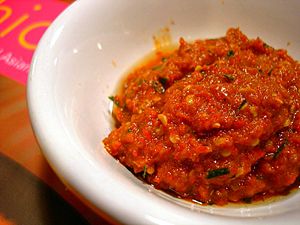
Chilli peppers are a must-have in Malaysian kitchens. Both fresh and dried forms are used. Chillies come in different sizes, shapes, and colors. Generally, two types are most common: the bird's eye chilli (cili padi), which is small but very hot, and longer varieties, which are much milder. Green chillies taste more peppery, while red chillies (which are ripened green chillies) have a slightly sweeter heat. If you want a milder flavor, remove the seeds and membranes from the chillies, or leave them whole and take them out before serving. Common uses include grinding chillies into a paste or sambal; chopping fresh chillies as a side or garnish; and pickling whole or cut chillies.
Belacan is essential to Malaysian cooking. It's a type of shrimp paste pressed into a block and sun-dried. Raw, it has a strong smell. Once cooked, its smell and flavor become milder and add depth to the dish. To prepare belacan, you usually wrap a small amount in foil, then roast it over a flame or in an oven. Belacan is most often pounded or blended with local chilli peppers, shallots, and lime juice to make sambal belacan, the most popular relish in Malaysia. Belacan is also crumbled into a ground spice paste called rempah, which usually includes garlic, ginger, onions or shallots, and fresh or dried chilli peppers. A rempah paste is similar to an Indian masala paste or Thai curry paste. It's often browned (tumis) to soften the raw flavors and create a balanced taste.
The coconut (kelapa) is another key part of Malaysian cuisine. Almost all parts of the plant are used for cooking. The white fleshy part of the coconut can be grated, shredded, and used fresh; dried to make desiccated coconut; or toasted until dark brown and ground to make kerisik. Grated coconut flesh is also squeezed to make coconut milk, which is used a lot in savory dishes and desserts. Coconut oil is used for cooking and beauty. Coconut water, the clear liquid inside, is a popular cool drink in Malaysia's hot and humid climate. Gula melaka is unrefined palm sugar from the sap of the coconut flower. It's the most traditional sweetener in Malaysian cooking, giving a rich caramel-like flavor with a hint of coconut. Coconut leaves are traditionally used to wrap food. Hollowed coconut husks and shells can be used as charcoal for barbecued meats and traditional pastry making. Even the growing tip of the coconut palm is a popular treat in rural areas and special restaurants.
Soy sauce of different types is another important ingredient. Light soy sauce adds a pleasant salty flavor to stir-fries, marinades, and steamed dishes. In some hawker stalls, freshly sliced or pickled chillies come in light soy sauce for dipping. Dark soy sauce is thicker, has a stronger flavor, and is less salty. It's often used when a richer flavor is wanted, especially in masak kicap (a style of cooking with soy sauce) dishes, and also to make a dish darker. Kicap manis, a sweetened soy sauce sometimes flavored with star anise or garlic, is also a popular seasoning. The sweet and savory taste of kicap manis can also replace a mix of dark soy sauce and thick caramel sauce, which is mainly used to color and season stewed dishes.
Common herbs include lemongrass (serai), a grass with a lemony smell and taste. Young, fresh stems are better because older ones can become woody. The soft white part closest to the base is thinly sliced and eaten raw in salads, or pounded with other spices to make a rempah. It's also used whole in boiled and simmered dishes. The pandan (screwpine) leaf is like vanilla in Western cooking. Its subtle smell is released when the leaves are tied into a knot, and it's used for cooking curries, rice, and desserts. The leaves can also be used to wrap foods like rice, chicken, or fish for cooking. Pandan leaf is also available as a liquid or powder to flavor and color cakes. Turmeric (kunyit) is a rhizome popular for its flavor and coloring. The leaves and flowers of the turmeric plant are also used in cooking or eaten raw.
Tofu products, especially fried tofu, are widely used in cooking and as side dishes. While fried tofu can taste plain on its own, it adds texture and, especially with tofu puffs, soaks up the flavor of whatever it's cooked in. Fried tofu products are versatile ingredients for dishes like stir-fried noodles, rojak (fruit and vegetable salad), noodle soups, and stews. A popular way to serve fried tofu on its own is as a salad with bean sprouts, shredded cucumber, and spring onions, covered in a thick sweet and spicy dressing and sprinkled with roasted ground peanuts. Fried tofu can also be stuffed with ground meat or shredded vegetables.
Dried seafood products add a savory depth of flavor to some Malaysian dishes. Small dried anchovies, known as ikan bilis, are very popular. They become crispy when deep-fried and are served as a side dish or made into a sambal relish. Ikan bilis is also boiled to make fish stock. In fact, instant ikan bilis stock granules are a popular seasoning in modern kitchens. Dried shrimp and salted dried fish are also used in various ways.
Other essential seasonings and garnishes include tamarind (asam jawa), specifically the paste-like pulp from the fruit pod, which adds a tart flavor to many dishes. Candlenuts (buah keras) look similar to macadamia nuts, being round, cream-colored, and high in oil. Candlenuts are usually ground to thicken sauces. Lup cheong is a type of dried Chinese sausage made from pork and spices. Mainly used by the Malaysian Chinese community, these sweet sausages are usually sliced very thinly and added for extra flavor and texture.
How Meals are Structured
There isn't one standard breakfast (sarapan) menu in Malaysia because of its many ethnic groups and modern influences. Western-style breakfasts like breakfast cereal, cooked eggs, and toast are common at home and when eating out. But heartier traditional meals, mostly based on noodles and rice, are still very popular. You might start the day with nasi lemak or kuih; try Chinese-style congee, dim sum, and noodle soups; or choose Indian-influenced foods like roti canai, idli, thosai, and upma. In Kelantan, nasi berlauk means a breakfast meal with a small serving of rice and side dishes (lauk).
For lunch and dinner, food is usually served all at once, not in separate courses. A meal might be a single dish for one person, or rice with many shared dishes for a group. At restaurants where food is cooked to order, there's often no difference between appetizers and main courses, and food comes to the table when it's ready. In some traditional eateries with pre-cooked food, diners serve themselves by starting with a plate of plain rice and choosing from a buffet of dishes. Like the Indonesian Nasi Padang, this isn't an all-you-can-eat meal for a fixed price. The cost depends on what you choose and how many different items you put on your plate. In Malay warung (small family eateries) or restaurants (kedai makan), this style of dining is called nasi campur, meaning "mixed rice." A similar idea exists at some places serving home-style Malaysian Chinese food, where it might be called economy rice (Chinese: 杂饭).
A practice called "open house" (rumah terbuka) is popular during festive seasons, and also for birthdays and weddings. Open house events are traditionally held at the host's home: everyone, no matter their background, is invited. The host provides home-cooked or catered food at their own expense. Guests can bring gifts for the host, but they are expected to eat as much as they like. Open house events can also be held at restaurants and larger public places, especially when hosted by government groups or companies.
Places to Eat
A kopitiam is a traditional coffee shop where people go for meals and drinks. They are mostly run by Chinese owners, especially from the Hainanese community. The word kopi is Malay/Hokkien for coffee, and tiam is Hokkien and Hakka for shop (Chinese: 店). Common in Malaysia and Singapore, their menus often include nasi lemak, boiled eggs, roti bakar (toasted bread), noodle dishes, and kuih. Some kopitiam owners rent space to independent stallholders, who might offer more specialized dishes. Typical drinks include Milo, a chocolate malt drink loved by Malaysians of all ages, as well as coffee (kopi) and tea (teh). Diners use special slang terms to order and customize drinks.
The ever-present Mamak stall is a Malaysian icon. Found throughout the country, especially in cities, Mamak stalls and restaurants offer a wide range of food, and some are open 24 hours a day. The owners are from Malaysia's Tamil Muslim community, who have created a unique cooking style and have a huge influence on Malaysian food culture. A buffet-style meal served at some Mamak eateries is called nasi kandar, similar to the Malay nasi campur, where you pay for what you eat. Diners choose from various curried dishes made with chicken, beef, mutton, or seafood. A mix of curry sauces is then poured over the rice, a style called banjir (meaning "flooding").
Malaysian Cuisines
Malay Cuisine
For a traditional Malay meal, rice is the main part, with everything else being a side dish or relish. Malay cuisine is very similar to Indonesian cuisine, especially some regional styles from Sumatra. It has also been influenced by Chinese, Indian, Thai, and many other cultures over time, creating its own distinct food. Some regional Malay dishes, like arisa and kacang pool, show influence from Arab cuisine due to long historical and religious ties. Many Malay dishes start with a rempah (spice paste), which is usually stir-fried in oil (tumis) to bring out flavors and form the base of a dish. A dipping sauce called sambal is an essential side for most Malay dishes.
- Air bandung - a cold milk drink flavored with rose syrup, making it pink. The name "Bandung" here means something that comes in pairs or is mixed from many ingredients.
- Asam pedas - a sour and spicy stew, with tamarind and chili as key ingredients. Depending on the region, tomatoes, lady's fingers, shredded torch ginger bud, and Vietnamese coriander (Malay: daun kesum) might be added. Usually cooked with fish like mackerel or stingray, but some recipes use chicken or even oxtail.
- Ayam goreng - a general term for deep-fried chicken, usually marinated in turmeric and other seasonings before cooking.
- Ayam masak merah - This dish means "red-cooked chicken." Chicken pieces are first fried until golden, then slowly cooked in a spicy tomato sauce. Peas are sometimes added, and it's garnished with shredded kaffir lime leaves and coriander. It's often eaten with nasi tomato - rice cooked with tomato sauce or paste, milk, dried spices, and a stir-fried rempah base of garlic, onions, and ginger.
- Ayam percik - also known as ayam golek in some states, this is grilled marinated chicken basted with a spiced coconut milk gravy.
- Bubur lambuk - a savory rice porridge eaten during the fasting month of Ramadan. It's made with lemongrass, spices, vegetables, and chicken or beef. It's usually cooked together at a local mosque and given out to people to break their fast each evening. In Terengganu, bubur lambuk is made with wild herbs, budu (fish sauce), sweet potatoes, and seafood.
- Gulai - the Malay word for a curried stew. The main ingredients can be chicken, beef, mutton, various internal organs, fish, seafood, and vegetables like cassava leaves and green jackfruit. The gravy is usually yellowish-brown from the stir-fried and browned rempah and added ground turmeric. The gravy's thickness can vary.
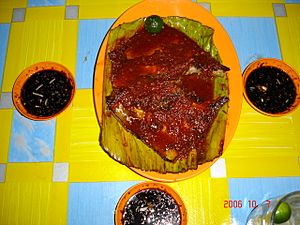
- Ikan bakar - barbecued or grilled fish, usually covered with a sambal sauce. It might also come with air asam, a dip made from shrimp paste, onion, chillies, and tamarind juice.
- Ikan goreng - a general term for shallow or deep-fried fish, which is almost always marinated before cooking. There are countless recipes for this popular way of cooking fish in Malaysia.
- Kerabu - a type of salad that can be made with any mix of cooked or uncooked fruits and vegetables, and sometimes meat or seafood. There are many kerabu recipes that are quite different. For example, kerabu taugeh is made with blanched bean sprouts and Malay ingredients like kerisik, while kerabu mangga (shredded green mango salad) tastes like a Thai-style yam salad.
- Keropok lekor - a specialty from Terengganu and other states on the east coast of Peninsular Malaysia. It's a savory fritter made from a mix of batter and shredded fish. Sliced and fried just before serving, it's eaten with hot sauce.
- Ketupat - a type of compressed rice, wrapped in a woven palm leaf pouch. As the rice boils, it expands to fill the pouch and becomes compressed. This cooking method gives ketupat its unique shape and texture. It's usually eaten with rendang (a dry beef curry) or served with satay. Ketupat is also traditionally served during festivals like Eid (Hari Raya Aidilfitri) as part of an open house meal.
- Laksam or Laksang - a different type of laksa found in the northern and northeastern states of Peninsular Malaysia. Laksam has thick, flat rice noodle rolls in a rich, slightly sweet white gravy made of minced fish, coconut milk, and shredded herbs.
- Masak lemak is a cooking style that uses a lot of turmeric-seasoned coconut milk. Proteins like chicken, seafood, smoked meats, and shellfish, perhaps with fruits and vegetables like bamboo shoots, pineapples, and tapioca leaves, are often cooked this way. Some states are known for a specific version of this dish. For example, masak lemak cili api/padi is a famous specialty of Negeri Sembilan.
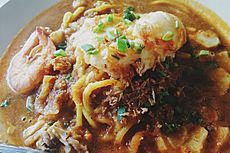
- Mee Bandung Muar - A traditional noodle dish from Muar made with yellow noodles and an egg, in a thick broth-gravy from dried shrimps, onion, spices, shrimp paste, and chillies. Prawns, meat, fish cakes, and vegetables are also added.
- Mee Siput Muar, a deep-fried circular dried noodle snack from Muar, Johor, made from flour and eaten with sambal.
- Nasi dagang - rice cooked with coconut milk and fenugreek seeds, served with a fish gulai (usually tuna), fried shaved coconut, hard-boiled eggs, and vegetable pickles. Nasi dagang ("trader's rice" in Malay) is a common breakfast dish in the northeastern states of Kelantan and Terengganu. It's often sold alongside nasi lemak for breakfast on the east coast of Peninsular Malaysia.
- Nasi goreng - a general term for fried rice, with many different versions. Variants include Nasi goreng kampung, Nasi goreng pattaya, and Nasi paprik.
- Nasi kandar - steamed rice served with various curries and side dishes. It's a popular northern Malaysian dish from Penang.
- Nasi ulam - rice salad mixed with thinly shredded herbs and greens (like daun kaduk, daun cekur, daun kesum), pounded dried shrimp, kerisik, and chopped shallots. A popular version on the eastern coast of Peninsular Malaysia is called nasi kerabu, which is blue-colored rice served with various herbs, dried fish or fried chicken, crackers, pickles, and vegetables.
- Rendang - a spicy meat and coconut milk stew from the Minangkabau people of Indonesia, many of whom settled in Negeri Sembilan. Buffalo meat is traditional, but beef and chicken are more commonly used today. The addition of kerisik (toasted coconut paste) is a distinct Malaysian touch. Rendang is traditionally made by the Malay community for festivals, served with ketupat or nasi minyak.
- Roti jala - The name means "net bread" in Malay. A special ladle with five holes is used to make its lacy pattern. Roti jala is usually eaten with curry or as a dessert with a sweet dipping sauce.
- Roti john - a spiced meat omelette sandwich, popular for breakfast or as a snack.
- Sambal - The term sambal refers to both a relish-like sauce made from chilli peppers pounded with ingredients like belacan and lime juice, and a cooking style where meat, seafood, and vegetables like brinjal (sambal terung) and stink bean (sambal petai) are cooked in a spicy sambal-based sauce.
- Satay - one of Malaysia's most popular foods. Satay (written as sate in Malay) is made from marinated beef and chicken pieces skewered on wooden sticks and cooked on a charcoal grill. It's usually served with compressed rice, sliced onions, cucumber, and a spiced peanut gravy for dipping. The town of Kajang in Selangor is famous for its satay; Sate Kajang means a style of sate where the meat chunks are bigger, and the sweet peanut sauce comes with fried chili paste.
- Sup kambing - a hearty mutton soup slowly cooked with aromatic herbs and spices, garnished with fried shallots, fresh cilantro, and a wedge of calamansi lime. Other versions include soups with beef (daging), beef ribs (tulang), or oxtail (buntut/ekor), all seasoned with the same herbs and spices.
- Tempoyak - fermented durian, traditionally stored in a jar. Tempoyak can be eaten as a relish or added to stews as a main flavor (masak tempoyak).
Javanese-influenced Food
Some Malaysian dishes clearly show Javanese influences or are directly from Javanese cuisine. These were brought to Malaysia by Javanese immigrants who have become part of the wider Malay community. Javanese cuisine is quite different from main Malay cooking, known for its simplicity and sweeter flavors, unlike main Malay cuisine which is often complex and spicy, based on regional foods from Sumatra. A popular way to serve Javanese-influenced food in southern Peninsular Malaysia is called nasi ambang, which involves shared platters of white rice with sides like chicken cooked in soy sauce or curry, stir-fried noodles, sambal goreng, fried shredded coconut, egg, and vegetables.
- Ayam penyet - deep-fried chicken that is smashed before serving. The other key part of this dish is a spicy sambal. Other sides include cucumbers, fried tofu, and tempeh.
- Lontong - vegetables stewed in a lightly spiced coconut milk soup, usually served with compressed rice and extra toppings. It's eaten during festivals and as a breakfast meal. In Indonesia, this dish is called sayur lodeh, and the compressed rice is lontong.
- Mee rebus - a dish with egg noodles covered in a spicy, flavorful sauce thickened with cooked and mashed root vegetables. Versions of mee rebus in other parts of Malaysia are sometimes called mee jawa, possibly hinting at its Javanese origin.
- Soto - Meat broth, usually served with plain rice, lontong, or noodles, depending on the region and personal choice.
- Tempeh - a main source of protein in Javanese cuisine, made by fermenting soybeans into a cake, similar to a firm vegetarian burger patty. It can be cooked and served in many ways.
Malaysian Chinese Cuisine
Malaysian Chinese cuisine comes from the cooking traditions of Chinese Malaysian immigrants and their descendants. They have changed their cooking under the influence of Malaysian culture and the ways Chinese people moved to Malaysia. Since most Chinese Malaysians are descendants of immigrants from southern China, Malaysian Chinese cuisine is mainly based on dishes from Cantonese cuisine, Hakka cuisine, Fujian cuisine, and Teochew cuisine.
As these early immigrants settled in different parts of what was then British Malaya and Borneo, they brought their food traditions and recipes from China. These gradually mixed with the characteristics of their new home in Malaysia while still staying distinctly Chinese. For example, Hainanese chicken rice is usually flavored with tropical pandan leaves and served with chili sauce for dipping, and it tastes different from typical chicken dishes found in Hainan Island itself. Some of these foods and recipes became strongly linked to a specific city, town, or village, eventually becoming famous and popular across the country today.
Chinese food is very common in areas with many Chinese communities, at roadside stalls, hawker centers, and kopitiam, as well as in cafes and fancy restaurants. Many Chinese dishes use pork, but chicken is available as a substitute for Muslim customers, and some Chinese restaurants are even `halal`-certified.
Here are some examples of Malaysian Chinese dishes found nationwide:
- Bak Kut Teh (Chinese: 肉骨茶) (pork ribs soup). The name "Bak Kut" (Hokkien dialect) means meaty ribs. It's simply cooked with garlic, dark soy sauce, and a special mix of herbs and spices, boiled for many hours. People see it as a health tonic. This soup was historically eaten by hard-working Chinese laborers at Port Swettenham (now Port Klang) and clearing estates, along with strong tea ("Teh"). There are some differences in seasoning among other Chinese communities; the Teochew prefer a clear broth with more garlic and pepper, while the Cantonese might add more medicinal herbs. Variations include chik kut teh (made with chicken, popular with Muslim diners), seafood bak kut teh, and a "dry" (less gravy) version from Klang.
- Bakkwa (Chinese: 肉干) - literally "dried meat," but it's more like barbecued meat jerky. This treat is especially popular during Chinese New Year, but it's available and eaten all year as a snack.
- Bean sprouts chicken (Chinese: 芽菜雞) - Ipoh's most famous dish. It has poached or steamed chicken with a plate of blanched local bean sprouts in a simple soy sauce and sesame oil dressing. The crunchy texture of Ipoh-grown bean sprouts comes from the mineral-rich local water. The dish is usually served with hor fun noodles in chicken broth, or plain rice.
- Cantonese fried noodles (Chinese: 廣府炒) refers to noodles that are shallow or deep-fried until crispy. They are then served as the base for a thick white sauce made with egg and cornstarch, cooked with sliced lean pork, seafood, and green vegetables like choy sum. A variation called yuen yong (Chinese: 鴛鴦) mixes both crisp-fried rice vermicelli and hor fun for the base. A related dish called wa tan hor (Chinese: 滑旦河) uses hor fun noodles, but they are only charred, not deep-fried.
- Char kway teow (Chinese: 炒粿條,炒河粉). Stir-fried rice noodles with bean sprouts, prawns, eggs (duck or chicken), chives, and thin slices of preserved Chinese sausages. Cockles and lardons used to be standard, but are now often optional due to changing tastes and health concerns. Penang-style char kway teow is highly regarded in Malaysia and abroad.
- Chee cheong fun (Chinese: 豬腸粉) is square rice sheets made from a thick mix of rice flour and water. This liquid is poured onto a special flat pan and steamed to make the sheets. The steamed rice sheets are rolled or folded for easy serving. It's usually served with tofu stuffed with fish paste. The dish is eaten with a semi-sweet fermented bean paste sauce, chili paste, or light vegetable curry gravy. Ipoh and Penang have different versions; some stalls in Ipoh serve it with a red sweet sauce, thinly sliced pickled green chillies, and fried shallots. In Penang, a sweet, black shrimp sauce called hae ko is the main condiment.
- Chicken rice (Chinese: 雞飯) - one of the most popular Chinese-inspired dishes in Malaysia. Hainanese chicken rice (Chinese: 海南雞飯) is the best-known version. It's made using the same traditional method as Wenchang chicken: the whole chicken is steeped in a master stock at just below boiling temperature until cooked, making the meat moist and tender. The chicken is then chopped and served with rice cooked in chicken fat and chicken stock, a bowl of clear chicken broth, and various dips. Sometimes the chicken is dipped in ice to make the skin jelly-like. In Malacca, the chicken rice is shaped into balls.
- Curry Mee (Chinese: 咖喱面). A bowl of thin yellow noodles mixed with bihun in a spicy curry soup enriched with coconut milk. It's topped with tofu puffs, prawns, cuttlefish, chicken, long beans, cockles, and mint leaves, with sambal on the side. It's often called curry laksa.
- Fish ball (Chinese: 鱼丸、鱼蛋、鱼圆) are fish paste shaped into balls. They are usually served with rice vermicelli or yellow noodles in a clear soup. Bean sprouts and spring onions are also commonly added, along with a small plate of chilli padi soaked in soy sauce. Fishcake is also a common addition.
- Hakka mee (Chinese: 客家麵) - A simple dish of noodles topped with a ground meat gravy. A popular hawker dish with Hakka roots, it's based on an older recipe called Dabumian (Chinese: 大埔麵), named after Dabu County (Chinese: 大埔县), a center of Hakka culture in China.
- Heong Peng (Chinese: 香饼) - These fragrant pastries, which look like slightly flattened balls, are a famous specialty of Ipoh. They are now widely available in Malaysia and even exported. They have a sweet, sticky filling made from malt and shallots, covered by a flaky baked crust and topped with sesame seeds.
- Hokkien Mee (Chinese: 福建炒麵) actually has two versions, each common in a different part of Peninsular Malaysia.
- Penang Hokkien mee, also known as hae mee (Chinese: 蝦麵) elsewhere in Malaysia. One of Penang's most famous specialties, it's a noodle soup with yellow and rice noodles in a flavorful stock made from prawns and pork (chicken for `halal` versions). It's garnished with a boiled egg, poached prawns, chopped kangkung, and a dollop of spicy sambal.
- Hokkien char mee, a dish of thick yellow noodles braised and fried with thick black soy sauce and crispy lardons, is more common in the Klang Valley. It started in Kuala Lumpur. So, in central Peninsular Malaysia, "Hokkien mee" refers to this version.
-
Ipoh white coffee (Chinese: 怡保白咖啡). A popular coffee drink that started in Ipoh. Unlike the strong dark roast for typical Malaysian black coffee ("Kopi-O"), "white" coffee is made only with palm oil margarine, without sugar and wheat, resulting in a much lighter roast. It's usually made richer with condensed milk before serving. This drink inspired the OldTown White Coffee restaurant chain, and instant versions are widely available in Malaysia and even internationally.
 Iced Ipoh white coffee in Menglembu, Ipoh, Malaysia
Iced Ipoh white coffee in Menglembu, Ipoh, Malaysia - Kam Heong (Chinese: 金香) - literally "golden fragrance" in English. Kam Heong is a cooking method developed in Malaysia, showing the country's mix of cultures. It involves stir-frying aromatic spices with bird's eye chillies, curry leaves, crushed dried shrimp, curry powder, oyster sauce, and other seasonings. This creates a versatile stir-fry sauce that goes well with chicken, clams, crabs, prawns, and squid.
- Lor mee (Chinese: 滷麵). A bowl of thick yellow noodles served in a thickened gravy made from eggs, starch, and pork stock.
- Marmite chicken (Chinese: 妈蜜鸡) - a unique dish of marinated fried chicken pieces glazed in a syrupy sauce made from marmite, soy sauce, maltose, and honey. This dish can also be made with other ingredients like pork ribs and prawns.
- Claypot chicken rice (Chinese: 瓦煲鸡饭) - chicken rice served in a claypot, traditionally cooked over charcoal. Common additions include salted fish and lap cheong. Bercham, a suburb in Ipoh, is famous for claypot chicken rice.
- Oyster omelette or O-chian (Chinese: 蚝煎) - small oysters are stir-fried on a hot plate, then mixed into an egg batter with moistened starch for thickening, and finally fried until crispy. Unlike other versions, Malaysian-style oyster omelettes are never covered in a thick savory gravy; chili sauce is served on the side for dipping.
- Pan mee (Chinese: 板面) - noodle soup with hand-kneaded and torn pieces of noodles or regular machine-pressed noodle strips, with a chewy texture like Italian pasta. A popular version in the Klang Valley is "Chilli Pan Mee," which has cooked noodles served with minced pork, a poached egg, fried anchovies, and fried chili flakes (added to taste). Chilli Pan Mee comes with a bowl of clear soup and leafy vegetables.
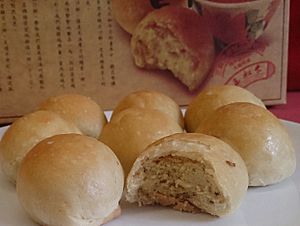
- Popiah (Chinese: 薄饼) - Hokkien/Teochew-style crepe stuffed and rolled with cooked shredded tofu and vegetables like turnip and carrots. The Peranakan version has shredded bangkuang (jicama) and bamboo shoots, seasoned with tauchu (fermented soybean paste) and meat stock. Another version has popiah covered in a spicy sauce. Popiah can also be deep-fried like a Chinese spring roll.
- Tau sar pneah (Chinese: 豆沙饼) - A famous Penang treat, this round Chinese pastry mainly contains green bean paste, and its ingredients include wheat flour, sugar, and salt. It's also known as Tambun biscuits, believed to have originated from Bukit Tambun, Penang. Its popularity makes it a must-buy souvenir from Penang.
- Wonton Mee (Chinese: 雲吞麵) - thin egg noodles with wonton dumplings (Chinese: 雲吞), choy sum, and char siu. The dumplings are usually made of pork or prawns, and typically boiled or deep-fried. The noodles can be served in broth with dumplings, like the traditional Cantonese way. But in Malaysia, it's more commonly dressed with a dark soy sauce, with boiled or deep-fried wonton dumplings on top or served on the side in broth. Variations often involve different meat toppings like roast pork, braised chicken feet, and roast duck.
- Yong tau foo (Chinese: 酿豆腐) - tofu products and vegetables like brinjals, lady's fingers, bitter gourd, and chillies stuffed with fish paste or surimi. Originally from Ampang, Selangor, Malaysian yong tau foo is a local version of a Hakka dish called ngiong tew foo (stuffed tofu with ground pork paste) and is usually served in a clear broth, with or without noodles.
- Yusheng (Chinese: 鱼生) - a festive raw fish salad, also called yee sang in Cantonese. While raw fish dishes existed in ancient China, yusheng was created in Singapore in 1964 when it was part of Malaysia. It has strips of raw fish tossed at the dining table with shredded vegetables, crispy bits, and a mix of sauces. Yusheng means "raw fish," but because "fish" (鱼) sounds like "abundance" (余), it's seen as a symbol of abundance, prosperity, and energy. So, mixing and tossing yusheng with chopsticks has become a ritual for Chinese New Year in Malaysia and Singapore.
- Lei Cha (Chinese: 擂茶) - This flavorful drink is a Hakka staple. Recipes differ, but generally, green tea leaves are added to a mix of salt, ground mint leaves, toasted sesame seeds, and nuts. The mixture is ground into a fine powder, then brewed into a drink. It tastes salty, minty, and is very nutritious.
Malaysian Indian Cuisine
Malaysian Indian cuisine, or the food of the ethnic Indian communities in Malaysia, includes adapted Indian dishes and new creations inspired by Malaysia's diverse food culture. Since most of Malaysia's Indian community are ethnic Tamils from Tamil Nadu in India and Sri Lanka's Northern Province, much of Malaysian Indian cuisine is mainly South Indian inspired. A typical Malaysian Indian dish will likely have curry leaves, whole and powdered spices, and fresh coconut in different forms. Ghee is still widely used for cooking, though vegetable oils and palm oils are now common in home kitchens. Before a meal, it's customary to wash hands as cutlery is often not used, except for a serving spoon for each dish.
Food served in the traditional South Indian way is called banana leaf rice. Plain white or parboiled rice is served with various vegetable dishes, lentil gravy, pickles, and papadum crackers on a banana leaf, which acts as a disposable plate. Banana leaf meals are eaten to celebrate special events like festivals, birthdays, marriages, or to remember funerals. It's customary to eat banana leaf meals by hand and to show appreciation by folding the banana leaf inwards. Less ritual is observed when the meal is not a formal occasion, like the Malayalee community's elaborate Sadya feasts. Boiled eggs, meat, or seafood dishes are available at banana leaf restaurants that are not strictly vegetarian or vegan.
Some notable Malaysian Indian dishes include:
- Chapati - a North Indian style flatbread. It's made from a dough of atta flour (whole grain wheat), water, and salt. The dough is rolled into discs and browned on both sides on a hot, dry pan without oil. Chapatis are usually eaten with curried vegetables, and pieces of the chapati are used to scoop up the food.
- Fish head curry - a dish where the head of a fish (usually ikan merah, or "red fish") is cooked in a thick and spicy curry gravy with vegetables like lady's fingers and brinjals.
- Idli - made from a mashed mix of skinned black lentils and rice, shaped into patties using a mold and steamed. Idlis are eaten for breakfast or as a snack. They are usually served in pairs with vadai (small donut-shaped fritters made from mashed lentils and spices), chutney, and a thick stew of lentils and vegetables called sambar.
- Maggi goreng - a unique Mamak-style version of mee goreng (stir-fried noodles), using cooked Maggi instant noodles instead of yellow egg noodles. The noodles can be stir-fried with bean sprouts, chili, greens, eggs, tofu, and choice of meat, though no two Mamak eateries have the exact same recipe. It's usually served with a calamansi lime.
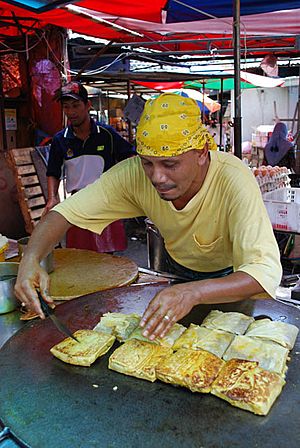
- Murtabak - a savory dish of stuffed roti canai (flatbread) eaten with curry gravy. A typical recipe has minced meat seasoned with garlic, onions, and spices, folded with an omelette and roti canai. Murtabak is popular with a side of sweet pickled onions during the fasting month of Ramadan.
- Murukku - a savory snack of spiced crunchy twists made from rice and urad dal flour, traditionally eaten for Deepavali.
- Nasi Beriani or Biryani - a rice dish made from a mix of spices, basmati rice, yogurt, meat, or vegetables. The ingredients are ideally cooked together in the final stage, which takes time. Pre-mixed biryani spices are easily available now to reduce preparation time.
- Pasembur - a salad of shredded cucumber, boiled potatoes, fried bean curd, turnip, bean sprouts, prawn fritters, spicy fried crab, and fried octopus. This Penang Mamak specialty is served with a sweet and spicy nut sauce. Versions of this dish are found in other states as Mamak rojak.
- Poori - an unleavened deep-fried bread made with whole-wheat flour, commonly eaten for breakfast or a light meal. A larger North Indian version made with leavened all-purpose flour or maida is called bhatura.
- Putu Mayam - the Indian version of rice noodles, also known as idiyappam. Homemade versions are eaten with curried dishes or dal. The street food version is usually served with grated coconut and orange-colored jaggery. In some areas, gula melaka is the preferred sweetener.
- Roti canai - a thin, unleavened bread with a flaky crust, fried on a skillet with oil and served with side dishes. It's sometimes called roti kosong. Many variations of this classic dish can be found at Mamak eateries, either created by the cook or requested by customers. Examples include: roti telur (fried with eggs), roti bawang (fried with thinly sliced onions), roti bom (a smaller, denser, usually round roti), roti pisang (banana), and so on.
- Roti tissue - a version of roti canai made as thin as a piece of 40–50 cm round tissue. It's then carefully folded by the cook into a tall, conical shape. Roti tissue can be served with curry gravy, dal, and chutneys, or finished with sweet things like caramelized sugar and eaten as a dessert.
- Teh tarik - literally meaning "pulled tea," teh tarik is a beloved Malaysian drink. Tea is sweetened with condensed milk and prepared by pouring hot tea back and forth between two mugs, stretching it out. The higher the "pull," the thicker the froth. This pulling also cools the tea. Teh tarik is an art form, and watching the tea stream can be captivating. Similar drinks include kopi tarik ("pulled coffee"); teh halia, tea brewed with ginger; and teh madras, which has three layers: milk at the bottom, black tea in the middle, and foam on top.
- Thosai, dosa or dosai - a soft crepe made from a batter of mashed urad dal and rice, left to ferment overnight. The batter is spread thinly on a flat, preheated griddle. It can be cooked as is (resulting in a foldable, soft crepe), or a dash of oil or ghee can be added and it's toasted for crispier results.
- Vadai, vada or vades - a common term for many different types of savory fritter-like snacks from South India with common ingredients. The most common ingredients are lentils, chillies, onions, and curry leaves.
Sabahan Food
The food of Sabah shows the many different ethnic groups living there and is very diverse. Traditional Kadazandusun cooking mostly involves boiling or grilling and uses little oil. From simple appetizers of seasoned unripe mango to various pickled foods called noonsom, tangy and strong flavors from souring agents or fermentation are key to traditional Kadazandusun cooking. Rice wine is part of all Kadazandusun celebrations, and at a Murut event, you'll see many jars of fermented tapioca tapai. Today, few eateries in Sabah serve traditional native dishes, though you'll always find them at festivals like weddings and funerals, and at the Kaamatan and Kalimaran cultural festivals. Chinese-influenced dishes like northern Chinese potstickers and Hakka stuffed tofu, along with many new creations developed in Sabah's inland settlements by immigrants from both northern and southern China throughout the 20th century, are common on menus in many kopitiam and upscale restaurants.
Sabah is known for its excellent seafood, temperate produce, and tea (Sabah tea is protected) grown in the highlands of Mt. Kinabalu. It also has a small coffee industry, with Tenom coffee considered the best in the region. Local ingredients like freshwater fish, wild boar (bakas in native languages), bamboo shoots, wild ferns, and various jungle produce are still important in the daily diet of local people. Since many rural communities still rely on farming for income, small festivals are held each year in certain towns to celebrate important produce: the Pesta Jagung (Corn Festival) of Kota Marudu, the Pesta Rumbia (Sago Festival) of Kuala Penyu, and Pesta Kelapa (Coconut Festival) from Kudat. Sabah vegetable, also known as cekuk manis or sayur manis (Chinese: 树仔菜), can be found on menus throughout Sabah. It's one of the local names for a type of Sauropus albicans grown in Lahad Datu, which produces crunchy edible shoots in addition to its leaves. The flavor is like spinach but more complex, "as if it had been strengthened with broccoli and infused with asparagus," and it's usually stir-fried with eggs or seasonings like sambal belacan.
Whether grilled, cured, deep-fried, steamed, stir-fried, braised, served raw, or made into soups, Sabah's seafood is famous for its freshness, quality, and good value. A huge variety of fish, squid, crabs, shellfish, sea cucumbers, and jellyfish are mainstays on lunch and dinner menus at kopitiam, restaurants, and simple food stalls all over Kota Kinabalu and other coastal towns like Sandakan, Tawau, Lahad Datu, and Semporna. Seafood with noodles is also popular for breakfast. Every day, locals go to special eateries where they can get various fish-based products to start the day. Examples include: poached patties handmade with fresh fish paste; deep-fried fish cakes wrapped in tofu skin; and noodle soups with toppings like sliced fish fillet, fish or prawn balls, and fish insides. Some eateries even serve "noodles" made from fresh fish paste.
Edible seaweed is a traditional food for some seaside communities in Sabah and is also protected. Latok looks like green fish eggs or grapes and is usually prepared as a salad by the Bajau people. Coral seaweed is another popular sea plant product. Recently, it's been sold as a healthy gourmet food to locals and tourists, called "sea bird's nest" (Chinese: 海底燕窝) because it becomes gelatinous when dissolved in water.
Among the foods and drinks special to Sabah are:
- Amplang is a type of cracker made from Spanish mackerel, tapioca starch, and other seasonings, then deep-fried.
- Bahar or baa is the Kadazandusun version of palm wine made from sap collected from a young coconut tree's flower bud and a special tree bark called rosok, found only in the Tuaran district. Pieces of rosok are dipped into the coconut nectar during fermentation, which gives the final product a reddish color.
- Beaufort Mee (Chinese: 保佛炒面) is a specialty of Beaufort town. Handmade noodles are smoked, then stir-fried with meat (usually slices of char siu and marinated pork) or seafood and lots of choy sum, and finished with a thick, sticky gravy.
- Bosou, also called noonsom or tonsom, is the Kadazandusun term for a traditional tangy fermented meat. Smoked and crushed buah keluak (nuts from the Kepayang tree, Pangium edule, which grows in Malaysia's mangrove swamps), or pangi, is a key ingredient and acts as a preservative. Mixed with rice, salt, and fresh meat or fish, the mixture is sealed in a jar for fermentation. Modern versions add bananas and pineapples. Pinongian is a version without rice, which tastes less tangy; however, unlike bosou, pinongian must be cooked before serving.
- Hinava is a traditional Kadazandusun dish of raw fish cured in lime juice. Typically, firm white fish like mackerel (hinava sada tongii) is marinated with lime juice, sliced shallots, chopped chili, julienned ginger, and grated dried bambangan fruit seed. Sliced bitter gourd can be added. Hinava can also be made with prawns (hinava gipan).
- Lihing is a rice wine made only from glutinous rice and natural yeast called sasad. It tastes bittersweet and is a specialty of the Kadazan Penampang community, where it's still commonly brewed at home. Lihing can be used to make chicken soup (Sup Manuk Lihing), in marinades, or as an ingredient for meat pastries and stir-fried dishes. Commercially made lihing, though more expensive, is consistent in quality and available in some souvenir shops. Lihing and similar rice wines from other Kadazandusun communities can also be distilled to make a strong liquor called montoku or talak.
- Ngiu chap (牛什) is a Chinese-influenced dish of beef or buffalo broth served with noodles, usually in the soup with slices of poached beef or buffalo meat, meatballs, stewed brisket, tendon, liver, and various internal organs. A famous Sabahan dish, ngiu chap has many variations, from the lighter Hainanese style to heartier Hakka-influenced flavors, and even village-style ngiu chap adapted for native tastes.
- Pinasakan or Pinarasakan is a home-style Kadazandusun dish of fish simmered with takob-akob (dried skin of a mangosteen-like fruit used for sourness) or slices of unripe bambangan, as well as fresh turmeric leaves and root.
- Pinjaram (or Penyaram) is a Bajau and Bruneian Malay heritage food. It's famous and popular almost everywhere in Sabah and can be found in night markets and Tamu (Sabah weekly market).
- Sagol or sinagol is a Bajau specialty of fish that is first blanched and minced, then stir-fried with turmeric, garlic, ginger, onions, and crushed lemongrass. Traditionally, the oil used is rendered fish liver oil, usually from the same fish. This dish can be made with shark, stingray, and even puffer fish.
- Sang nyuk mian (Chinese: 生肉面) is a dish of noodles served with pork broth, from Tawau. Very popular with non-Muslim communities in Sabah, it's named after the tender, marinated pork slices poached to order in pork broth flavored with fried lard bits. The noodles (usually thick yellow noodles) are either dressed in dark soy and lard, or put into the soup with the pork slices, vegetables, meatballs, and internal organs.
- Sinalau refers to Kadazandusun style smoked meat, usually wild boar or bakas. Barbecued on a grill and eaten with rice and dipping sauces, sinalau bakas can be found in rural areas and towns. `Halal` versions use other game meats like deer instead of wild boar.
- Tuhau (Etlingera coccinea) is a type of wild ginger, specifically the stems of the plant, often served as a relish by the Kadazandusun community. The stems are usually chopped and served fresh with lime juice, or mixed with local chives and chili peppers, then cured with salt and vinegar. A newer recipe, serunding tuhau, involves slicing tuhau stems into thin, floss-like shreds, then stir-frying them until golden and crispy. It has a unique scent that some people love and others dislike, even among native Sabahans.
Sarawakian Food
Sarawakian food is quite different from the regional foods of Peninsular Malaysia. It's considered less spicy, prepared lightly, and focuses more on subtle flavors. The most important spice in Sarawakian cuisine is pepper. Pepper is grown on a large scale and is the local cooks' favorite for adding heat to a dish. Sarawak black pepper is highly regarded by international chefs.
While the Iban people are the largest Dayak group and the most numerous ethnic group in Sarawak, most of them still live away from Sarawak's main cities, in longhouse communities scattered across the state's interior. The traditional cooking of the Iban is called pansoh or pansuh, which means preparing and cooking food in bamboo tubes. Ingredients like chicken, fish, pork, vegetables, or rice are mixed with fragrant herbs like lemongrass, tapioca leaves, and bungkang leaves (a type of myrtle), then sealed inside bamboo tubes and placed directly over an open fire. Cooking food this way gives it a special aroma and flavor from the bamboo while keeping it moist.
During Dayak festivals like Gawai, the Iban slaughter locally raised pigs. After cleaning, the pig's head and stomach are removed, and the rest is cut into smaller pieces for barbecuing. The head and stomach are usually prepared separately as they are considered the best parts; thus, pig's heads are a common gift brought by visitors to an Iban longhouse. Dishes like pork stomach cooked with pineapples are a must for Gawai.
Sarawak is known for its rice; three varieties grown in Sarawak have been granted protected status. Among the foods and drinks special to Sarawak are:
- Belacan bihun is rice vermicelli dressed in a gravy made from ground chillies, belacan, tamarind, and dried shrimp. It's garnished with cured cuttlefish, shredded cucumber, bean sprouts, and century egg wedges.
- Bubur pedas is a type of rice congee cooked with a special spice paste, or rempah, made from turmeric, lemongrass, galangal, chillies, ginger, coconut, and shallots. It's a fairly complex and spicy dish compared to most congee and is often prepared during Ramadan for breaking fast.
- Daun ubi tumbuk or pucuk ubi tumbuk is a preparation of cassava leaves (called empasak by the Iban) that has a pesto-like consistency. It's widely eaten among Sarawak's native communities. The pounded leaves can be stir-fried with seasonings like anchovies and chili, stuffed into a bamboo tube and roasted, or simply boiled with shallot, fat, and salt.
- Ikan terubuk masin is salt-preserved toli shad, found only in the coastal waters of Sarawak. It's a famous delicacy and a prized food gift.
- Kasam ensabi is a fermented vegetable pickle made from a native type of mustard greens (ensabi) and is traditional to the Iban community.
- Kolo mee or mee kolok (Chinese: 干捞面) is a dish of springy egg noodles tossed in a sweet and savory shallot, lard, and vinegar dressing, topped with seasoned minced pork and char siu. It's similar to Peninsular-style Hakka mee or wonton mee but tastes quite different. A popular version uses oil from cooking char siu instead of plain lard, giving the noodles a reddish color. `Halal` versions replace pork with beef (called mee sapi) or chicken, and lard with peanut or vegetable oil. Other toppings can include mushrooms, chicken, and crab meat. Kampua mee (Chinese: 干盘面) is a similar dish from Sibu of Fuzhou origin.
- Laksa Sarawak or Kuching Laksa (Chinese: 古晉叻沙) is noodles (usually rice vermicelli) served in a flavorful spiced coconut milk soup, topped with shredded chicken, shredded omelette, bean sprouts, prawns, and garnished with coriander.
- Manok kacangma is a Chinese-influenced dish. It has chicken pieces cooked with ginger and kacangma (Chinese: 益母草), often seasoned with some Chinese wine or tuak by non-Muslim cooks.
- Manok pansoh is the most typical Iban pansoh chicken dish. Chicken is seasoned with bungkang leaves, lemongrass, ginger, and tapioca leaves, then stuffed into a bamboo tube and roasted in a traditional fireplace. A related Bidayuh dish is Asam Siok, which adds rice to the chicken mix. These dishes are not common in city restaurants because it's hard to roast bamboo tubes over an open fire in a typical kitchen.
- Nasi goreng dabai is rice stir-fried with dabai (canarium odontophyllum), a native fruit found only in Sarawak. It's often compared to an olive because of its similar look and taste. Since dabai spoils quickly and is seasonal, this dish is also made with preserved dabai paste.
- Nuba laya is cooked Bario rice that is mashed and wrapped in leaves of the phacelophrynium maximum plant. It's considered the main part of a meal for the Lun Bawang and Kelabit people. Sides might include a small bowl of porridge (kikid), shredded beef cooked with wild ginger and dried chili (labo senutuq), deboned shredded fish (a'beng), and various wild jungle vegetables.
- Sup Terung Dayak is a popular soup made with a native type of wild eggplant, which is round and slightly larger than an orange. Also called terung asam because of its natural tart flavor, this eggplant comes in bright yellow to orange colors. Other ingredients for the soup might include fish, prawns, or fish products (dried, salted, or smoked fish).
- Tebaloi is a sago biscuit snack traditionally linked to the Melanau people of Sarawak.
- Three layer tea or Teh C Peng Special is an iced drink with brewed tea, evaporated milk, and gula apong (palm sugar) syrup, carefully layered without stirring. Originally from Kuching, its popularity has spread to other areas of Sarawak and neighboring Sabah.
- Tuak is a type of alcohol traditional to Sarawak's Dayak communities. It's most commonly made from fermented regular or glutinous rice, but there's no strict definition of what tuak is. Tuak is essentially any alcoholic drink made by fermenting carbohydrates in Sarawak by Sarawakians. The Bidayuh are especially known for their skill in brewing tuak: ingredients for different tuak versions include sugarcane (tepui), tampoi (a wild fruit with a sweet and tart flavor), pineapples, and apples. Tuak is usually served as a welcome drink to guests and is an important part of rituals and festivals like Gawai and Christmas. Tuak can also be distilled to make a spirit called langkau.
- Umai is a traditional Melanau food, served with a bowl of baked or toasted sago pearls. There are two versions of umai: the traditional sambal campur and a more modern sambal cecah jeb. The first is a raw seafood salad with raw sliced seafood (fish, prawns, even jellyfish) cured in calamansi lime juice, tossed with ground peanuts, sliced onions, and chillies. For umai jeb, the raw sliced seafood is plain and simply dipped into a spicy sauce.
- White Lady is a chilled drink made with milk, mango juice, longan, and pineapple. Invented in 1975 by a Kuching hawker, many variations can be found in various hawker stalls throughout the city.
Peranakan Food
Peranakan cuisine, also called Nyonya food, was created by the Straits Chinese whose descendants live in Malaysia and Singapore today. The old Malay word nyonya (also spelled nonya), a respectful term for important women, now refers to the food of the Peranakans. It mainly uses Chinese ingredients but mixes them with Malay ingredients like coconut milk, lemongrass, turmeric, tamarind, pandan leaves, chillies, and sambal. It can be seen as a blend of Chinese and Malay cooking, with influences from Indonesian Chinese cuisine (for Malaccan and Singaporean Nyonya food) and Thai cuisine (for Penang Nyonya food). Traditional Nyonya cooking is often very detailed, takes a lot of effort, and is time-consuming. The Peranakan community often believes the best Nyonya food is found in private homes.
Examples of Nyonya dishes include:
- Acar - various pickled meats and vegetables like acar keat-lah (honey lime/calamansi), achar hu (fried fish), acar kiam hu (salt fish), acar timun (cucumber), acar awat (mixed vegetables).
- Asam Laksa (Mandarin: 亞三叻沙). Considered one of Penang's three signature dishes, Asam laksa is similar to the Malay laksa utara. It has translucent al dente rice noodles in a spicy soup made of fish (usually mackerel), tamarind (both asam jawa and asam gelugor), and daun kesum. Toppings vary greatly and can include onion, mint, chopped torch ginger flower, and slices of pineapple and cucumber. A dollop of strong, thick sweet fermented shrimp paste (Petis udang or Hae Ko) is usually served on the side.
- Ayam buah keluak, a chicken stew cooked with nuts from the Kepayang tree (Pangium edule). For this recipe, the contents of the buah keluak are scooped out and stir-fried with spices, then stuffed back into the nuts and cooked with the chicken pieces.
- Ayam/Babi Pongteh, a stew of chicken or pork cooked with tauchu (salted fermented soy beans) and gula melaka. It's usually salty-sweet and can be a soup dish in Peranakan cuisine. Pork is commonly used as this is a Peranakan version of Chinese braised pork belly.
- Babi assam, a pork stew cooked with tamarind juice. The Kristang community also makes a similar pork dish in tamarind gravy.
- Enche Kabin, deep-fried chicken pieces marinated in a paste of coconut milk and rempah (spices).
- Itik Tim or Kiam Chye Ark Th'ng is a soup of duck, preserved mustard greens, and cabbage flavored with nutmeg, Chinese mushrooms, tomatoes, and peppercorns.
- Jiu Hu Char is a dish mainly made of shredded vegetables like turnip or jicama, carrot, and cabbage, stir-fried with thinly shredded dried cuttlefish.
- Kari Kapitan is a Penang Nonya version of the common chicken curry. Kaffir lime leaves and coconut milk are key ingredients for this mild curry.
- Kerabu Bee Hoon is a salad dish with rice vermicelli mixed with sambal belacan, calamansi lime juice, and finely chopped herbs and spices. Other famous salad dishes are kerabu bok ni (cloud ear fungus), kerabu ke (chicken), kerabu ke-kha (chicken feet), kerabu timun (cucumber), kerabu kobis (cabbage), kerabu kacang botol (four angled bean), kerabu bak pue (pork skin).
- Kiam Chye Boey is a mix of leftovers from other dishes. "Boey" literally means "end."
- Laksa lemak is a type of laksa served in a rich coconut gravy, with prawns, cockles, lime, and a dollop of sambal belacan.
- Masak titik is a vegetable soup that uses a lot of white peppercorns. One version uses watermelon rind as the main ingredient. Another uses green or semi-ripe papaya.
- Nasi kunyit - glutinous rice seasoned with turmeric powder, coconut milk, and asam gelugur. It's usually served with chicken curry, ang koo kueh, and pink hard-boiled eggs as gifts to celebrate a child's first month.
- Otak-otak - a dish with fish pieces wrapped in banana leaves. Two very different versions exist: one has a mix of fish pieces and spice paste wrapped in banana leaves and grilled. This version is linked to Malacca and Muar, Johor. Penang-style otak-otak is a delicate steamed parcel, and instead of a strong red spice paste, it uses a spiced custard base and aromatic herbs like daun kaduk.
- Perut ikan - a spicy stew (similar to asam pedas in flavor) mainly with vegetables/herbs, getting its unique taste from fish bellies preserved in brine and daun kaduk (wild pepper leaf). A classic Penang Nyonya dish.
- Pie Tee - A thin and crispy pastry tart shell filled with a spicy, sweet mix of thinly sliced vegetables and prawns.
- Roti babi - a sandwich of spiced minced pork, dipped entirely in egg wash and deep-fried. Roti babi is usually served with a dip of Worcestershire sauce and sliced red chillies.
- Seh Bak - a dish of pork marinated overnight with herbs and spices, then cooked slowly until tender. Seh Bak is also traditional to Malacca's Eurasian community.
Eurasian Food
- Ambilla - a tangy dish of meat cooked with long beans (kacang), brinjals (terung), or pumpkin (labu).
- Curry Debal - a classic Kristang dish, usually cooked during Christmas to use leftover meats from feasting. It's a very spicy curry flavored with candlenuts, galangal, and vinegar.
- Curry Seku - a very dry curry prepared in a wok. Seku means "bottom" in Papia Kristang, and the wok was probably named for its round shape.
- Chicken pie - this meat pie, known as empada de galinha or galinha pia, is usually served during Christmas and other special occasions.
- Feng - a curried dish of pig offal, traditionally served for Christmas.
- Pang Susi - a savory meat bun with a sweet, bread-like dough, made for special occasions like Easter.
- Pesce Assa or commonly known as Ikan Bakar or Sambal stingray - Portuguese baked/grilled fish is one of the Kristang community's most famous specialties, now found in major cities throughout Malaysia. The fish is covered with diced lady's fingers and a strong sambal, then wrapped in banana leaves and metal foil, and cooked on a grill. Despite its name, this dish is quite different from modern Portuguese fish recipes.
- Semur or Smoore - a fragrant beef stew. Versions of this dish are found wherever the Dutch settled in Asia, including Malacca.
- Soy Limang - a braised dish of fried brinjals, with soy sauce and lime juice as the main seasonings.
Kuih (Delicacy) and Snacks
Kuih (plural: kuih-muih) are usually small, bite-sized foods linked to the Malay and Min-speaking Chinese communities of Malaysia. The word kuih can refer to various cakes, cookies, candies, pastries, and sweet treats. Kuih can be eaten throughout the day for a light breakfast, afternoon tea (a tradition from the British), as a snack, and increasingly as a dessert after meals.
Most kuih are steamed or fried and made from rice or glutinous rice. They are very different in texture, flavor, and appearance from Western oven-baked cakes or puff pastries. Most kuih are sweet and can be eaten as desserts, but some are savory. Kuih is an important part of festive occasions and is traditionally made at home, but now you can buy it from caterers, street vendors, market stalls, and special cafes, shops, and restaurants. It's hard to tell if a kuih is originally Malay or Peranakan (Straits Chinese) because the history of traditional kuih recipes isn't well documented, and cultures have influenced each other for centuries. Even the word kuih itself comes from the Hokkien/Teochew word 粿 (pronounced kueh or kway).
Examples of notable kuih-muih include:
- Ang koo kueh (Chinese: 紅龜粿) - a small round or oval-shaped Chinese pastry with a red, soft, sticky glutinous rice flour skin wrapped around a sweet filling.
- Apam balik - a folded pancake with a texture like a crumpet and crispy edges, made from a thin flour batter with a rising agent. It's usually cooked on a griddle and topped with sugar, ground peanuts, creamed corn, and grated coconut in the middle, then folded over. Many versions exist in Malay, Chinese, Peranakan, Indonesian, and Bornean communities, all with different names.
- Bahulu - tiny crispy sponge cakes in shapes like buttons and goldfish, made by baking in molded pans. Bahulu is usually baked and served for festive occasions.
- Cucur - deep-fried fritters, sometimes called jemput-jemput. Common types include cucur udang (fritters with a whole unshelled prawn), cucur badak (sweet potato fritters), and cucur kodok (banana fritters).
- Curry puff - a small pie filled with a curried filling, usually chicken or potatoes, in a deep-fried or baked pastry shell.
- Dadar/Ketayap - a rolled crepe (usually flavored with pandan juice) filled with grated sweet coconut filling (flavored with palm sugar).
- Jelurut - also known as kuih selorot in Sarawak, this kuih is made from a mix of gula apong and rice flour, then rolled with palm leaves into cones and and steamed.
- Kapit, sapit or sepi - crispy folded coconut-flavored wafer biscuits, often called "love letters."
- Kochi - glutinous rice dumplings filled with a sweet paste, shaped into pyramids and wrapped with banana leaves.
- Niangao (Chinese: 年糕) or kuih bakul - a brown, sticky, sweet rice cake usually linked to Chinese New Year. It's also available all year as a popular street food, made with pieces of niangao sandwiched between slices of taro and sweet potato, dipped in batter, and deep-fried.
- Onde onde - small round balls made from glutinous rice flour, colored and flavored with pandan, filled with palm sugar syrup, and rolled in fresh grated coconut.
- Pineapple tart - flaky pastries filled with or topped with pineapple jam.
- Pinjaram or penyaram - a saucer-shaped deep-fried fritter with crisp edges and a dense, chewy center. It's widely sold by street food vendors in East Malaysia's open-air markets.
- Putu piring - a round steamed cake made of rice flour dough with a palm sugar-sweetened filling.
- Seri Muka - a two-layered kuih with steamed glutinous rice forming the bottom half and a green custard layer made with pandan juice.
- Wajid or wajik - a compressed Malay sweet made of glutinous rice cooked with coconut milk and gula melaka.
Examples of snacks include:
- Lekor - A keropok fish cracker snack.
- Mee Siput Muar - A deep-fried circular dried noodle snack, made from flour with other ingredients, eaten with sambal.
- Rempeyek - A deep-fried savory cracker, made from flour with other ingredients, bound or coated by crispy flour batter.
Desserts and Sweets
Desserts and sweets in Malaysia are very diverse because of its many ethnic groups and cultures. Traditional Malay and Nyonya desserts often share common features: they use lots of coconut milk, and are usually flavored with gula melaka (palm sugar) and pandan leaves. Some notable desserts include:
- Agar agar - The Malay word for a type of red algae. It's a natural vegetarian gelatin used to make puddings and flavored jellies like almond tofu, as well as fruit aspics.
- Ais kacang - also known as air batu campur or ABC. This dessert has a base of shaved ice, colored syrup, and evaporated or condensed milk with various toppings. These can include sweet corn, red beans, kidney beans, cincau (grass jelly), cendol, buah atap (fruit of the nipa palm), soaked basil seeds, peanuts, and ice cream.
- Aiskrim potong - an ice cream popsicle made from coconut milk or milk, flavored with local ingredients like red beans, rose syrup, durian, pandan, creamed corn, and jackfruit. Its texture is different from Western ice cream; aiskrim potong is less creamy and slightly starchy when it starts to melt.
- Batik cake - a type of chocolate cake similar to hedgehog slice made using Marie biscuits.
- Bubur cha cha - a Nyonya dessert of bananas, sweet potatoes, taro, black eyed beans, and sago pearls cooked in pandan-flavored coconut milk. It can be served hot or cold.
- Bubur kacang hijau - mung bean porridge cooked with coconut milk and sweetened with palm or cane sugar.
- Bubur pulut hitam - black glutinous rice porridge cooked with palm sugar and pandan leaves, served hot with coconut milk.
- Cendol - smooth green droplets made from mung bean or rice flour, usually served by itself in chilled coconut milk and gula melaka, or as a topping for ABC. In Malacca, mashed durian is a popular topping for cendol.
- Dodol - a sweet, sticky, thick, toffee-like candy, made with heavily reduced coconut milk, jaggery, and rice flour. Commonly served during festivals like Eid ul-Fitr and Eid al-Adha as sweet treats for children.
- Keria Gula Melaka - a type of doughnuts made of sweet potato and coated with smoky gula Melaka, Malaysian palm sugar.
- Ladoo - the most popular Indian sweet in Malaysia, especially during Diwali/Deepavali. Ladoo comes in many flavors. A typical recipe involves cooking chickpea flour, semolina, and ground coconut in ghee.
- Leng Chee Kang (Chinese: 莲子羹) - a mix of cooked ingredients in a sweet soup. Ingredients vary, but lotus seed is always the main one. The soup might include dried longan, white fungus, barley, kembang semangkuk jelly, and rock sugar. Leng Chee Kang can be served warm or cold.
- Matterhorn - crushed ice with pineapples, longan, cendol, grass jelly, and lemon slices. The Kuching hawker who created this popular dessert and the original White Lady drink was inspired by the Matterhorn, an ice-capped mountain.
- Mooncake (Chinese: 月饼) - round or rectangular pastries with a rich, thick filling, traditionally eaten during the Mid-Autumn Festival with Chinese tea. Both the traditional baked mooncake and the snow skin version are popular and widely available in Malaysia during the festival season.
- Nanggiu - a Kadazandusun dessert, consisting of jelly noodles made from fresh sago flour cooked in a coconut milk soup sweetened with palm sugar.
- Pandan cake - colored and flavored with pandan juice, this light and fluffy cake is also known as pandan chiffon.
- Payasam - a sweet spiced pudding made from starchy foods like rice or vermicelli. Payasam is an important part of traditional South Indian culture.
- Pengat - a soupy dessert cooked with gula melaka and coconut milk. Also known as serawa, pengat is made with pieces of fruit like banana, jackfruit, and durian, or root vegetables like sweet potatoes and tapioca. It can be reduced into a thick dipping sauce and served with glutinous rice, roti jala, or pancakes (lempeng).
- Pisang goreng - a common snack sold by street vendors. Battered fried bananas are also served in a fancier way at some cafes and restaurants as a dessert. Cempedak and various root vegetables are also battered and fried in the same way as variations.
- Puding Diraja - also known as Royal Pudding, this dessert was created and served to the royal family of Pahang state. Its main ingredients are pisang lemak manis (a local banana), evaporated milk, prunes, candied cherries, and cashew nuts. The pudding is garnished with jala emas, and served with a cold sauce made from milk and cornflour. Nowadays, it's popularly served during Ramadan, and as a special afternoon tea treat for families on weekends.
- Sago pudding - a dessert of cooked translucent sago pearls, which can be served as a liquid dessert with coconut milk and palm sugar, or allowed to set as a pudding (sagu gula melaka) and drizzled with thickened coconut milk and gula melaka syrup.
- Sarawak layer cake - these famously complex layer cakes are essential for festivals celebrated throughout Sarawak, like Hari Raya, Chinese New Year, Gawai, and Christmas.
- Sugee cake - a baked specialty of the Eurasian community, made with semolina flour and a high amount of egg yolks.
- Tangyuan (Chinese: 汤圆 or 湯圓) - plain white or colored sweet dumplings made from glutinous rice flour. Traditionally homemade and eaten during Yuanxiao and the Dongzhi Festival, tangyuan is now available all year as a dessert. Filled tangyuan dumplings are usually served in a lightly sweetened clear syrup, while unfilled ones are served as part of a sweet dessert soup.
- Tapai - a popular dessert in Malay homes during Hari Raya, made from fermented glutinous rice or tapioca. Tapai can be eaten alone or with modern toppings like ice cream, chocolate, and fruit. It's not to be confused with the alcoholic drink from Sabah, also called tapai, which is made from the same ingredients but has fermented longer to produce alcohol.
- Tau foo fah or Dau Huay (Chinese: 豆腐花 or 豆花) - a velvety pudding of very soft silken tofu, traditionally flavored with a brown sugar syrup.
- UFO tart (Chinese: 牛屎堆) - this consists of a flat, thin base of baked mini butter sponge cake topped with a creamy egg custard, which is then crowned with a meringue slurry. Its Chinese name means "cow pile dung," referring to the piped shape of the cake's toppings and the meringue's darker color from caramelization. Popularized by a Hainanese bakery in Sandakan in the 1950s, these treats have spread to Kota Kinabalu and other towns in Sabah.
See also
 In Spanish: Gastronomía de Malasia para niños
In Spanish: Gastronomía de Malasia para niños


